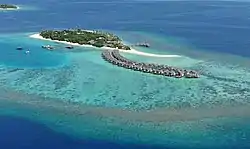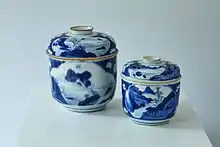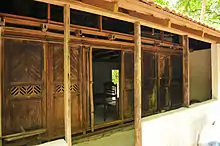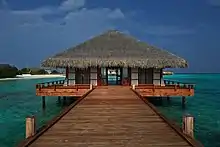Maamigili | |
|---|---|
 Aerial shot of Maamigili Island | |
 Maamigili Location in Maldives | |
| Coordinates: 05°40′05″N 72°52′30″E / 5.66806°N 72.87500°E | |
| Country | Maldives |
| Administrative atoll | Northern Maalhosmadulhu Atoll |
| Distance to Malé | 186.92 km (116.15 mi) |
| Dimensions | |
| • Length | 0.700 km (0.435 mi) |
| • Width | 0.500 km (0.311 mi) |
| Time zone | UTC+05:00 (MST) |
Maamigili is one of the uninhabited islands of Raa Atoll in the Maldives.
The island measures 750 meters in length and 500 meters in width for 100 hectares of coral reef.
Maamigili can be reached via a 45-minute seaplane ride from the capital Malé and through the new Ifuru domestic airport,15 minutes away from the island by speed boat.
Loama Resort Maldives at Maamigili is a resort situated on the island. The resort maintains a collection of historical artifacts at Loama Museum, a nation’s heritage site with ancient baths and wells, and the Loama Art Gallery with contemporary local art.
Loama Museum

Loama Museum is the only official Museum in a Hotel in the Maldives. The young museum collection spans from the Classical to British Colonial Period. These include native artifacts, foreign objects from the Early Modern or Colonial Period (1514-1828) and British Colonial Period (1828-1965), an Ancient Bath from the Classical Period (500 BCE-1153), and mausoleums from the Medieval Islamic Period (1153-1514).[1] The museum leads to ancient baths and a traditional house, which are located at the heritage site.[2]
Exhibits include Chinese porcelain that arrived during the Indian Ocean trade between Southeast Asia and the Middle East. Other artifacts from the collection represent the lifestyle of these coral atolls for centuries in the Indian Ocean and include grain measures, coconut oil production methods and equipment for lace.[2]
Vevu[2]

Vevu (Dhivehi), also known as bathing tanks, were historically used as public baths and later for ablution. The construction period of these Vevu is uncertain, but the use of sandstone indicates a possibility in the pre-Islamic era (500 BCE-1153 CE). The symmetrical layout suggests a potential association with a temple. Similar baths can be found in other parts of the Maldives, some also featuring coral stone. The Vevu's construction involved layering sandstone blocks below the waterline up to half a meter above the ground. An octagonal ledge was cantilevered at low tide level to facilitate access to the well. Despite damages caused by natural and human factors during Maamigili's uninhabited period of at least 200 years, the Vevu is still regarded as an exemplary pre-Islamic coral stone structure.
Traditional house

As part of the museum exhibit, Loama Museum showcases a traditional Maldivian house with a history of over 125 years in Kandholhudhoo. The house incorporates South Asian architectural designs, featuring teak panels and coral stone walls. Its dimensions are approximately 20 feet by 12 feet, and it is furnished with functional items for daily living.
Loama Art Gallery

Loama Art Gallery is associated with the National Art Gallery, Maldives, and focuses on contemporary art from the region. It provides a platform for both established and emerging artists to showcase and sell their work to diverse audiences, both local and international. The gallery contributes to the evolving landscape of contemporary art in the Maldives, reflecting changing themes and styles over the past few decades.
See also
External links
References
- ↑ Jameel, Mauroof.Historic Periods of Maldives
- 1 2 3 bruce. "Best of the Maldives: Official Museum – Loama at Maamigili | Maldives Complete Blog". Retrieved 2022-11-16.